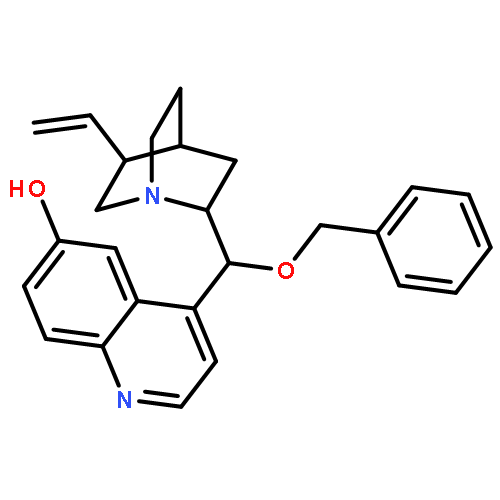Co-reporter:Pingping Chen, Yanhui Chen, Yuhan Zhou, Ying Peng, Jingping Qu and Masanobu Hidai
Dalton Transactions 2010 vol. 39(Issue 24) pp:5658-5663
Publication Date(Web):19 May 2010
DOI:10.1039/B921176D
The heterometallic cubane-type clusters [(Cp*Mo)3(μ3-S)4Au(PR3)][PF6][X] (Cp* = η5-C5Me5; 2a: R = Ph, X = BF4; 2b: R = Cy, X = PF6; 2c: R = tBu, X = PF6), [(Cp*Mo)3(μ3-S)4Ag(PPh3)][PF6][OTf] (3, OTf = OSO2CF3) and [(Cp*Mo)3(μ3-S)4CuI][PF6] (4) have been prepared by the reaction of [(Cp*Mo)3(μ2-S)3(μ3-S)][PF6] (1) with complexes [(R3P)Au][X], [(Ph3P)Ag][OTf] and CuI, respectively. These clusters have been spectroscopically and crystallographically characterized. In addition, the electrochemical properties of clusters 2a, 2b, 2c and 4 are also discussed.
Co-reporter:Yinsong Tao, Yuhan Zhou, Jingping Qu, Masanobu Hidai
Tetrahedron Letters 2010 Volume 51(Issue 15) pp:1982-1984
Publication Date(Web):14 April 2010
DOI:10.1016/j.tetlet.2010.02.017
A highly efficient and regioselective allylation reaction of amines with allylic alcohols under mild conditions catalyzed by the cubane-type sulfido cluster [(Cp∗Mo)3S4Pd(dba)][PF6] with H3BO3 as an additive has been developed. A variety of amines and allylic alcohols are investigated, and in the case of allylic alcohols bearing substituents at either α- or γ-position only linear allylic amination products are obtained.
Co-reporter:Na Xue;Yuhan Zhou;Guowei Wang;Weirong Miao
Journal of Heterocyclic Chemistry 2010 Volume 47( Issue 1) pp:15-21
Publication Date(Web):
DOI:10.1002/jhet.134
Co-reporter:Yuhan Zhou;Yanhui Chen;Weirong Miao
Journal of Heterocyclic Chemistry 2010 Volume 47( Issue 6) pp:1310-1316
Publication Date(Web):
DOI:10.1002/jhet.475
Co-reporter:Yanhui Chen, Yuhan Zhou and Jingping Qu
Organometallics 2008 Volume 27(Issue 4) pp:666-671
Publication Date(Web):January 25, 2008
DOI:10.1021/om0611148
The novel thiolate-bridged diiron complexes [Cp*Fe(μ2-SR)3FeCp*] (1, R = Et; 2, R = Ph) have been obtained by the reaction of [Cp*FeCl]2 with LiSEt or LiSPh in THF. Treatment of 1 with CO or CNtBu in THF gives complex [Cp*FeSEt(μ2-SEt)2FeCp*CO] (3) or [Cp*FeSEt(μ2-SEt)2FeCp*CNtBu] (4), while reaction of 1 with CNtBu in CH2Cl2 results in the formation of complex [Cl2Fe(μ2-SEt)2FeCp*CNtBu] (5). These five complexes have been spectroscopically and crystallographically characterized. In addition, the formation of 5 indicates that this class of clusters might serve as carbon−halogen bond activation reagents (catalysts), and carbon−halogen bond cleavage reaction of 4 is also described.
Co-reporter:Pingping Chen, Yanhui Chen, Yuhan Zhou, Ying Peng, Jingping Qu and Masanobu Hidai
Dalton Transactions 2010 - vol. 39(Issue 24) pp:NaN5663-5663
Publication Date(Web):2010/05/19
DOI:10.1039/B921176D
The heterometallic cubane-type clusters [(Cp*Mo)3(μ3-S)4Au(PR3)][PF6][X] (Cp* = η5-C5Me5; 2a: R = Ph, X = BF4; 2b: R = Cy, X = PF6; 2c: R = tBu, X = PF6), [(Cp*Mo)3(μ3-S)4Ag(PPh3)][PF6][OTf] (3, OTf = OSO2CF3) and [(Cp*Mo)3(μ3-S)4CuI][PF6] (4) have been prepared by the reaction of [(Cp*Mo)3(μ2-S)3(μ3-S)][PF6] (1) with complexes [(R3P)Au][X], [(Ph3P)Ag][OTf] and CuI, respectively. These clusters have been spectroscopically and crystallographically characterized. In addition, the electrochemical properties of clusters 2a, 2b, 2c and 4 are also discussed.
















![3H-Pyrazol-3-one,4-[(4-bromophenyl)methyl]-2,4-dihydro-5-methyl-2-phenyl-](http://img.cochemist.com/ccimg/656900/656836-52-1.png)
![3H-Pyrazol-3-one,4-[(4-bromophenyl)methyl]-2,4-dihydro-5-methyl-2-phenyl-](http://img.cochemist.com/ccimg/656900/656836-52-1_b.png)
![Benzoic acid, 4-[1-(trifluoromethyl)ethenyl]-, methyl ester](http://img.cochemist.com/ccimg/357300/357274-86-3.png)
![Benzoic acid, 4-[1-(trifluoromethyl)ethenyl]-, methyl ester](http://img.cochemist.com/ccimg/357300/357274-86-3_b.png)

